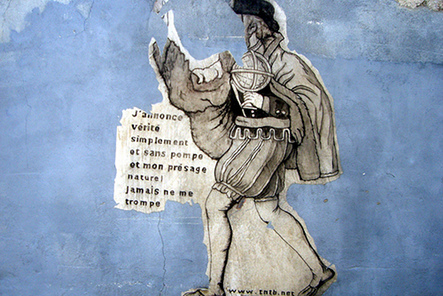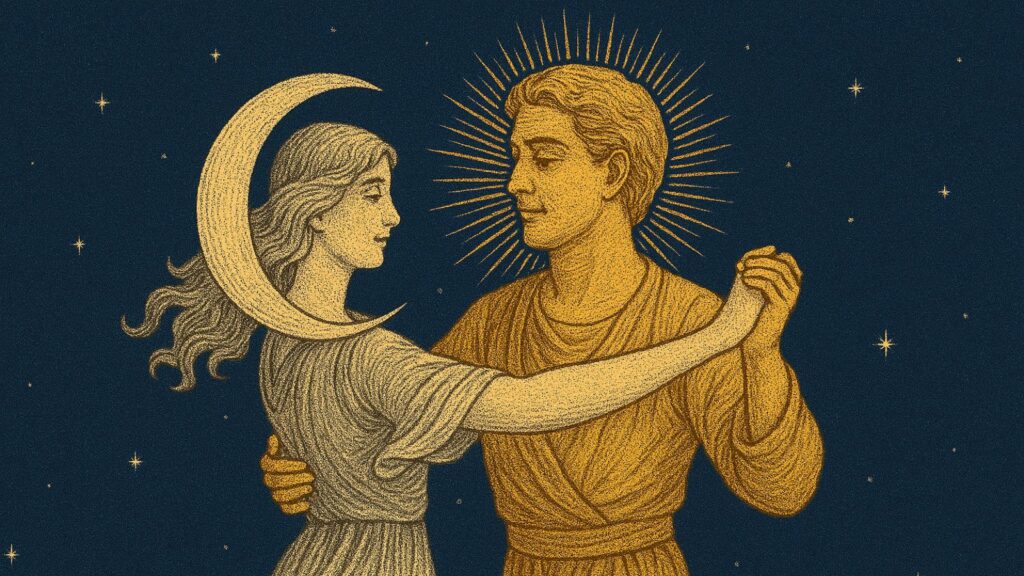The following is taken from The Essential Nostradamus just published by Tarcher.
If you were to take the years that have been earmarked as the due date for the End Times, you would find few over the last two millennia that have avoided this peculiar honor. The twelfth-century Italian prophet Joachim of Fiore contended that the year 1280 would mark the dawn of the Era of the Holy Spirit, the dawn of spiritual freedom for all. William Miller, a self-educated preacher in early nineteenth-century New York state, predicted on the basis of his intricate scrutiny of biblical texts that Christ would return sometime between March 21, 1843, and March 21, 1844. Although his followers were disappointed, they regrouped to form the various Adventist denominations that still survive today. In the late nineteenth century, Charles Taze Russell, a Pittsburgh haberdasher who delved into scriptural mysteries, claimed that 1874 marked the 6000th year of man’s creation and would inaugurate the Time of the End. Leaving a forty-year “harvest” period brought the target date to 1914. The events of that year seemed at first to prove Russell right, but, at his death in 1916, the Armageddon-like carnage of World War I was still continuing without any providential rescue. After the war had come and gone, Russell’s followers, known as Bible Students, decided that 1914 was the beginning of the end. The largest segment of these (renamed Jehovah’s Witnesses in 1931) later pointed toward a date of 1975, which their revised calculations indicated was the real 6000th year of man’s creation. But this year passed without any serious damage to the heavens or the earth. At the end of the twentieth century, Nostradamus’s date of 1999 was greeted with some apprehension, but, it too, proved to be like any other year.
New Age prophecy, which has retained the habit of apocalyptic speculation while detaching it from the Bible, is now looking toward 2012. It’s curiously appropriate that the best article I have read about the 2012 phenomenon appears on a website called Cracked.com. Written by Luis Prada, it is entitled “The Six Best 2012 Apocalypse Theories (and Why They Are All Bullshit).” Prada writes, “You may have noticed a recent trend of trying to fit every hackneyed doomsday prophecy into the same red- letter year of 2012. The theories are obtuse, their connections are flimsy and the perceived consequences are completely unsubstantiated. Unsurprisingly, these prophecies are enormously popular.”
Prada’s number one theory is credited to Nostradamus. But Nostradamus makes no reference to the year 2012 in any of his prophecies. Furthermore, when he does mention dates in the future — 1580, 1609, 1703, 1999 — they are almost always years in which nothing of any great moment occurred. Why, then, has he been connected with 2012? There is, frankly, no good reason. It is simply that Nostradamus has become associated with apocalyptic prophecies as a whole as Prada puts it, “No one else in history has caused more people to stockpile Spam in their bomb shelters” and so has the year 2012, so it was inevitable that the two would be connected.
Then there is the History Channel. Discovering that its most successful shows were not the ones that delved into the saga of the Kentucky rifle or the air tactics of the Third Reich, the network began producing specials on more exotic subjects such as Nostradamus and 2012. Here is the network’s own write-up of its show Doomsday 2012: The End of Days: “A surprising number of prophets from ancient oracles to contemporary Internet-crawling software ‘bots’ point to December 21, 2012 as the End of Days.” And for “Nostradamus 2012,” we are told, “December 21, 2012 is bearing down on us with alarming speed. Whether or not we are able to collectively heed the warnings and affect a course to avert disaster may be the defining moment of the modern age.” Presumably the “may” provides an out in case we don’t have to heed the warnings after all.
These documentaries have, of course, attracted critics. John Major Jenkins, author of Maya Cosmogenesis 2012, described the 2006 History Channel program Decoding the Past: Mayan Doomsday Prophecy (for which he was interviewed) as “45 minutes of unabashed doomsday hype and the worst kind of inane sensationalism.”
I doubt the History Channel will be dismayed by such characterizations certainly not as long as the ratings hold. I have appeared on some of these shows myself, and I can testify that the producers offscreen asking me the questions sometimes have trouble keeping a straight face.
All this said, these programs would not get such high ratings unless they met a need in the collective psyche. The thought of doomsday generates a weird pleasure in those probably including all of us who feel a deep ambivalence about advanced civilization. We are the creations of this civilization; we could scarcely survive for a week outside the shade of its umbrella; but it is so exacting and artificial that we often find ourselves hating and resenting it. Fantasizing about apocalypse offers a way, even if it is an unsatisfying way, of reconciling these contradictions in ourselves.
But why 2012? Popularizing this year as a target date for apocalypse (or universal spiritual renewal) was originally the work of Valum Votan, or, as he is more commonly known, José Argüelles, the alleged “closer of the cycle and messenger of the new time.”
Argüelles is best known as the prophet of the Harmonic Convergence of August 16-17, 1987, which attracted tremendous attention worldwide and is generally reckoned as the point at which the New Age entered mass culture an outcome that did not please Argüelles. As he told me in a 1998 interview, “It was the beginning of the New Age as commercial marketing, which was anything but our intention.”
At any rate, from his interpretation of the extraordinarily intricate Mayan calendar (or calendars — there are apparently seventeen different ones), Argüelles contended that August 16, 1987, marked the end of a “hell cycle” for this planet and that the next five years would be a time of cleansing in preparation for the dawning of a new era on December 21, 2012. Argüelles explains:
“In 2012, the Earth will be in a condition of rapid, unprecedented evolution and change due to the enlightenment of the human species for having returned to living according to the natural 13:20 cycles of time . . . . The oneness of humanity will be the result of the universal telepathy reawakened by returning to the natural cycles. Because of this fact, there will no longer be any need of government, and humanity will have abandoned industrial technology for the development of spiritual, telepathic fourth-dimensional technologies. Creature comfort needs will be supplied by applications of solar and telepathic crystal technologies. The human race will be living and fulfilling UR, the Universal Religion on Earth. The order of reality will be known as the Dominion of Time. Everyone will be getting ready for the great moment of galactic synchronization, July 26, 2013, Yellow Galactic Seed, the completion of the telepathic construction of Timeship Earth 2013 and the advent of the Planetary Manitou, the galactic brain on Earth.”
Arguelles urges the world to adopt the Mayan calendar, which is based on a beneficent “13:20” proportion — the Mayan tzolkincycle is 260 days or 20 times 13 instead of the pernicious “Babylonian” calendar, based on a “12:60” rhythm (with twelve months in a year), which, he contends, has warped and damaged human consciousness.
Argüelles’s ideas do not necessarily become clearer with further explanation. A more lucid account is provided by John Major Jenkins, who says that December 21, 2012, will be the day on which the point of the sun’s rising at the winter solstice coincides with the “Dark Rift” of the Milky Way, a gap in the galaxy as seen from the earth. The Mayans were aware of this “galactic alignment,” as Jenkins calls it, and believed that it portended a renewal and transformation of the age.”
Still another 2012 prophet is the late Terence McKenna, who in the 1990s replaced Timothy Leary as the pope of psychedelia. Making his own hypercomplicated calculations using the I Ching, he arrived at a date for the dawning of a historic “singularity” in mid-November, 2012, but changed it to the Mayan date when he learned of that.
These speculations dovetail with a widespread expectation that we are entering the age of Aquarius, although the date of this occurrence is far more tenuous. Again, it has to do with the point of the sun’s rising — in this case at the vernal equinox. Over the last 2,150 years (this figure is vague, as is its starting point), the sun has risen on March 21 with Pisces in the background. At some point it will rise, or has already started to rise, with Aquarius in the background: that will mark the dawning of the age of Aquarius. The dates for this event are unclear because there is no clear line between the zones of Pisces and Aquarius in the sky. Dates I have seen range from a.d. 1600 to 2500; C. G. Jung, in his work Aion, which deals in depth with the symbolism of Pisces, suggested that it might begin in 1997, for intricate astronomical reasons.
A third element that converges in this wave of New Age apocalyptic thought is the Hindu concept of the Kali Yuga, the age of darkness under which, it is widely agreed, humanity now labors. By one fairly standard calculation, this began on January 23, 3012 B.C., although its ending date is, again, a matter of dispute. Most Hindus believe that we are still in the Kali Yuga, although a few say it is over. Sri Yukteswar, teacher of the celebrated yogi Paramahansa Yogananda, argued that it actually ended in A.D. 1699.
The starting date for the Kali Yuga bears a curious though admittedly far from exact-resemblance to the beginning of the Mayan calendar cycle, which is 5,125.36 years in length. Reckoning back from 2012, this takes us back to August 11, 3114 B.C. not the same date as that of the commencement of the Kali Yuga by any means, but reasonably close. There is another, though even less exact, resonance with the traditional Jewish calendar, which dates the creation of the world at 3761 B.C. Although these dates span over 700 years, they fall in roughly the same era. Considering that traditional Jewish reckoning assigns a life span of 6,000 years to the world, we come to an ending date of A.D. 2239.
Most people will respond to these arcane reckonings in one of two ways: to dismiss them as too obscure or to embrace them precisely because of their obscurity. Practically everyone who looks forward to the 2012 target date as the deadline for planetary awakening understands the calculations only dimly but somehow believes that they portend an apocalypse of disaster or is it enlightenment?
It’s instructive to see how the 2012 prophecies have been manipulated by mass culture, notably by the History Channel. Nearly all of the 2012 visionaries see the date as a harbinger of a new and enlightened consciousness for humanity, but the wizards of television have transmogrified this vision into something that looks very much like a fundamentalist’s Last Judgment. Ironically, this may help explain why the phenomenon has become so popular. The apocalyptic genre has been a vibrant, if corrosive, part of Western civilization since the second century B.C. But today the Western mind has been secularized to the point where many people are likely to laugh at reckonings based on stray verses in Daniel, Ezekiel, and Revelation. At the same time, apocalyptic expectation remains so habitual in the Western consciousness that it still continues to look for signs of doomsday even when it has lost faith in the religions that gave birth to the concept. For the New Ager, or, if you like, the “cultural creative,” psychedelic visions, calendars created by the ancient Maya, the utterances of indigenous shamans, and calculations based on the I Ching as well as the pronouncements of Nostradamus are likely to have much more resonance and authority. Hence 2012.
Prophecy is far more significant for what it says about collective needs and wishes than for what it says about the future. And yet I would stop short of dismissing the 2012 prophecies whether or not they are adorned by gleanings from Nostradamus as entirely a matter of wish fulfillment. While it seems to me ridiculous to single out specific dates “of that day and hour knoweth no man” the general pattern seems to have some significance. As we’ve already seen, several traditional reckonings date the beginning of the current epoch to sometime around 3000 B.C. And one thing is unquestionably true about this period: it is the watershed between history and prehistory. This period around 5000 years ago marks the beginning of civilization as we know it in Egypt and Mesopotamia and India; of what went before, we know nothing except for fanciful myths and tenuous theories cooked up by archaeologists analyzing pottery shards. The world was not created in 3000 or 4000 B.C., but our world, the world of man in history, was indeed created then.
Unfortunately, history is a tale of crimes and follies and failures. Even its brightest moments are faint. A civilization reaches a sublime flowering, and a generation later plunges back into darkness and decadence. A saint emerges to remind humanity of wisdom and goodness; a few decades afterward his followers turn his teachings into an excuse for coercion and violence. On the whole, it is far from an inspiring story, and in a way the prediction that everything will continue as usual is as dark a forecast as the gloomiest mutterings of fanatics. Today we find ourselves saying, with Joyce’s Stephen Dedalus, “History is a nightmare from which I am trying to awake.” Do the prophecies for 2012, however ludicrous they may seem, underscore a hope that humanity will finally awaken collectively?
I believe they do. More than that I cannot say. I am not a prophet, and as this book proves, I do not believe in prophets. But I do sense that the human race is attempting to shake off a long and terrifying slumber. What will come after is sealed off by as impenetrable a wall as the one that shields us from prehistory.
Teaser image by Gastev, courtesy of Creative Commons license.













